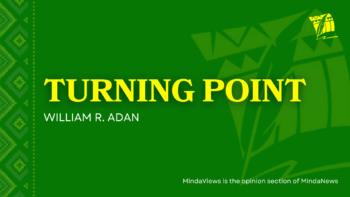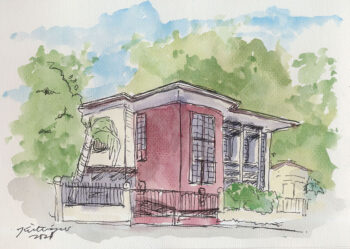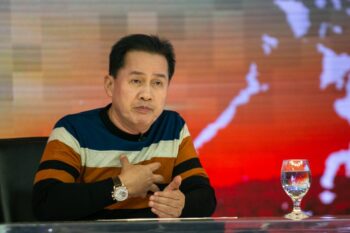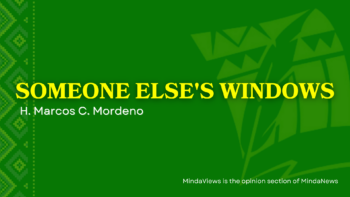QUEZON CITY (MindaNews / 14 Sep) – The rise of President Du30 is expected to open a new chapter in Mindanao peace process especially with the Administration’s proposal of federalism and Charter change. As envisioned, said proposals would provide the basis, framework, and parameters of any future political entity for the Bangsamoro as the country’s Fundamental Law will be rewritten in case it pushes through.
Displaying political will and leadership very early in his term while exerting influence in major political and military institutions of the country, the President is basking, at least initially, with high people’s support showing Du30’s ascendancy to realize a peace vision.
Narrative of tragedies
However, as the Bangsamoro peace process has long become a “narrative of tragedies” where the beginning of the term of certain administration often starts with so high a promise of peace only to deteriorate at the middle or end of its term, question is raised as to what makes the Du30 presidency exceptional that it would not succumb to the same tragedy or be exempted from the travail with what I used to refer as “sysyphean ordeal” of the Moro struggle.
Whereas there are peace agreements (e.g., Tripoli Agreement, Final Peace Agreement, Comprehensive Agreement on the Bangsamoro) that the government had signed with Moro fronts that could serve as template even partially in the formation of envisioned political structure for the Bangsamoro, their full use however hinges on the progress of federalism debate that is obviously still too inchoate as of date – that is, unless self-determination through total independence of the Muslim South from the Philippines is not relentlessly pursued by new and more spirited Moro collectives.
With the country’s lack of experience on federalism, concern is also raised how its purported promise would result in developing the country’s political system rather than further entrenching political dynasty and patronage in traditional area like Muslim Mindanao. Equally critical is how the Du30 government would have to deal with major Moro fronts and make them converge on common peace agenda and how to engage other militant groups that are increasingly becoming more problematic while posing an even more serious challenge and make them cohere, if possible, with Du30’s vision of peace and political restructuring.
Yet, as the malaise of mere political restructuring via tier-making and tier-changing in Mindanao and the Sulu Archipelago has simply resorted to numerous “failed political experiments,” question is raised whether Du30’s vision of federalism, which is, in a sense, another “experimental tier” would still be a viable option given the increasing ember of Moro struggle for self-determination, freedom, and independence. It is thus a question how Du30 would be able to break the malaise and doze off Moro separatist struggle with his vision of peace and federalism.
Du30’s unconventionality
Undoubtedly, people are now beginning to understand who Du30 is since throwing himself into limelight last year. They know that, unlike other politicians, Digong has his own mind, his own tack.
For lack of better term, we refer to such unique view on things by the President as part of “Digong’s unconventionality” – the source of his distinct take on a lot of issues, its rationality and unique context including consistency and contradiction with traditional paradigm of Philippine politics wherein instances of which often look or sound like “shock and awe” in both domestic issues and foreign relation.
Apart from his cussing and his tirade against US President Barrack Obama while raising to the world the massacre of 600 Tausug at Bud Dajo in Jolo in 1906 (as we will discuss it in a separate piece), forget the now generally accepted Du30’s “maong tagalog” and its rolled up long sleeve with Du30’s trademark of chewing gum while delivering speech. These are just small part of Digong’s “unconventionality.”
What we specifically meant by “unconventionality” is Du30’s independent way in looking at things and his personal approach in addressing issue or problem with the end, in Digong’s view, to optimize benefit as he tries to find more choices and other creative solutions to make the over-all gain of his plan part of broader goals of national development.
With less than a month in office, Digong’s “unconventionality” seems to work well. In recent survey, 92% of Filipinos trust Du30, although we don’t know how long he could sustain such high regard from Filipino public beyond the so-called honeymoon period of his presidency. However, while President Du30 may have high support given his rise as a populist president, it is not impossible that his too independent view on some critical issues could run counter with traditional policy orientation of the country. It is with much certainty that such a clash between Du30’s “unconventionality” with Philippine policy “convention” would inevitably create more stirs in various issues in the country. As the saying goes “the best (or worst?) is yet to come.”
We don’t know, too, how much patience the so-called “Du30’s unconventionality” has while still basking with strategic ambition and creativity and still far from what President Digong would often refer to as “reckoning.” Reckoning means Du30’s patience has limits.
In this regard, it is interesting to know if his “reckoning” has the same domestic and foreign policy latitude, say, if Du30’s patience in dealing with China is the same with his patience on local threat groups like the Abu Sayyaf and others. Or, if both threats could be dealt with sustained “strategic creativity.”
In this series, let us highlight Du30’s unconventionality on such issues like federalism, peace process, Bangsamoro, Misuari, and the Abu Sayyaf.
First, we are interested to underscore Du30’s federalism project with backdrop of the Bangsamoro both as an encapsulated history of a people struggling for self-determination that have embraced a generally protracted peace process; and, as a recently staled project of Pnoy Administration and Moro Islamic Liberation Front (MILF) and how Du30 views and tries to remedy them as he squares off particularly the soon-to-be converged Bangsamoro Basic Law (BBL) and Final Peace Agreement (FPA) with State interest together with Du30’s advocacy on federalism and Mindanawon.
Given the continuing debate on federalism, this point cannot be fully underscored yet; it can only be discussed continuously as it is contingent with the progress of federalism issue as well as the peace process.
Second, we want to know why, despite Misuari as a fugitive and facing rebellion charges while practically secluded in the Sulu hinterlands, Du30 is egging to meet Nur in his MNLF camp even planning to allow him to roam around Mindanao once again to consult his Moro National Liberation Front’s (MNLF) supporters like the way President Corazon Aquino and President Fidel Ramos did in mid ‘80s and ‘90s. While it appears that such proposed meeting is simply the urging of two friends – one a “rebel” at heart; the other a rebel in praxis – yearning to see each other, per Digong’s “unconventionality,” there seems to be more beyond it.
What is that “beyond” really is beginning to baffle some people. Despite his repeated remarks that he would talk with Misuari, yet when he visited the AFP troops in Jolo weeks ago, his meeting with Nur was aborted. Despite this, Du30 continues to insist that Nur should be on board of the peace process as he views him as the only Moro leader with stature and influence. This gives an aura of importance on Nur to the chagrin of other Moro leaders who have to even compete hard with other so-called leaders – pseudo or otherwise – to get an appointment with the president.
Moreover, while Du30 must be aware of strategic lapses in the conduct of past peace process with the Moro Islamic Liberation Front (MILF) that had strong consequence in the MNLF’s disagreement with the Aquino government due to heavy reliance on Malaysia’s facilitation that led into Sabah standoff and Zamboanga siege few years ago, question is raised why the seeming continuation of Aquino’s approach with the same Malaysia playing preponderant role in the peace process. This point is raised since before his inauguration, Du30 responded positively his support on the Sabah claim.
Question is raised too whether the above antecedents are already ominous in the finalization of the crack of the Bangsamoro into mainland Mindanao-based and those based in Western Mindanao and the Sulu Archipelago as conceived by President Du30. Moreover, last month’s promise to hold a Moro convention possibly among Moro fronts and their leaders failed to happen.
From Digong’s perspective, in a sense, the president could not be blamed for proposing the formal break-up of the Bangsamoro since the disunity of its constituent parts particularly the Moro fronts is more apparent than their unity. From Moro strategic perspective and in consonance with Moro’s concept of “national power,” any future arrangement of polity in the Bangsamoro must take into account the “unity” amongst their people and their territories. It is interesting to know the take of Moro fronts and other stakeholders on such proposal of a divided Bangsamoro per dictate possibly of some territorial nuancing identified with Mindanawon proponents of federalism.
Third, we want to find some hints why despite Du30, in his eid l-fitr speech in Davao, expressing that the Abu Sayyaf is not a criminal group; yet, after few visits to military camps in Mindanao, Basilan, and Sulu with spate of kidnappings and beheadings in the area notwithstanding the recent US$32-million assistance of the United States to the Philippines, Digong shifted his policy and poured in more than 10,000 AFP forces to Sulu and Basilan to fight a ragtag band of Abu Sayyaf. Question is raised whether such massive display of forces could intimidate the ASG given its resilience and tenacity without creating backlash like the Davao bombing few days ago.
Yet, with still remaining American forces in Mindanao primarily in Zamboanga City that were supposedly stationed to help the country in its fight against terrorism, question is raised also why Du30 would like to kick them out from the area and how realistic such a scenario notwithstanding the implications in the souring of relation between two historic allies. Arguably, this version of Du30’s unconventionality relative to the United States requires much nuancing and will be treated too in a separate piece.
Fourth, focus will be emphasized on the nuance of Du30’s proposed federalism and its interplay with Bangsamoro Basic Law, Final Peace Agreement, and the Autonomous Region in Muslim Mindanao (ARMM) and the prospective peace talks and peace strategy with Moro fronts including the strategic necessity in reaching out to other groups.
Finally, we want to anticipate how these aforementioned issues cohere with the overall peace policy and strategy of the Du30 presidency under the frame of federalism project, as we note, too, some internal and external dynamics, their politics, challenges, and prospects of Moro struggle. (To be continued.)
[Part of this series has been presented during the 8th State of the Presidency forum organized by the Center for People Empowerment in Governance held at the Assembly Hall, NCPAG, UP Diliman, on 28 July 2016. Most parts are continuing analysis of the author on the subject. MindaViews is opinion section of MindaNews. Julkipli Wadi is Professor of Islamic Studies, University of the Philippines.]







